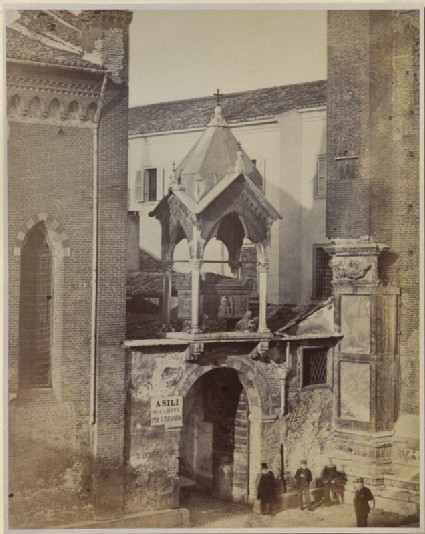Browse: 1470 objects
Photograph of the Castelbarco Tomb, Sant' Anastasia, Verona Anonymous Italian
-
Details
- Artist/maker
-
Anonymous Italian (Anonymous, Italian) (photographer)
- Object type
- photograph
- Material and technique
- albumen print
- Dimensions
- 267 x 212 mm (print); 274 x 217 mm
- Associated place
-
- Europe › Italy › Veneto (Venetia) › Verona › Verona › Chiesa di Sant' Anastasia › Chiesa di Sant' Anastasia (Castelbarco Tomb, subject)
- Europe › Italy › Veneto (Venetia) › Verona › Verona › Chiesa di Sant' Anastasia › Chiesa di Sant' Anastasia (subject)
- Inscription
- On the back of the mount:
top, left of centre, in graphite: R/93
just below, centre, in graphite: R 93
centre, in ink, struck through in graphite: 78
just below, the Ruskin School's stamp
- Provenance
-
Presented by John Ruskin to the Ruskin Drawing School (University of Oxford), 1875; transferred from the Ruskin Drawing School to the Ashmolean Museum, c.1949.
- No. of items
- 1
- Accession no.
- WA.RS.RUD.093
-
Subject terms allocated by curators:
Subjects
-
References in which this object is cited include:
References
Ruskin, John, The Ruskin Art Collection at Oxford: Catalogue of the Rudimentary Series, in the Arrangement of 1873, ed. Robert Hewison (London: Lion and Unicorn Press, 1984), cat. Rudimentary no. 93, RUD.093
Ruskin, John, Instructions in Practice of Elementary Drawing, Arranged with Reference to the First Series of Examples in the Drawings Schools of the University of Oxford (n.p., [1872]), cat. Rudimentary no. 93
Ruskin, John, Instructions in the Preliminary Exercises Arranged for the Lower Drawing-School (London: Smith, Elder, 1872), cat. Rudimentary no. 93
Ruskin, John, Instructions in the Preliminary Exercise Arranged For the Lower Drawing-School (London: Spottiswoode, 1873), cat. Rudimentary no. 93
Ruskin, John, ‘Rudimentary Series 1878’, 1878, Oxford, Oxford University Archives, cat. Rudimentary no. 93
Ruskin, John, ‘The Ruskin Art Collection at Oxford: Catalogues, Notes and Instructions’, Edward T. Cook and Alexander Wedderburn, eds, The Works of John Ruskin: Library Edition, 39 (London: George Allen, 1903-1912), 21, cat. Rudimentary no. 93
Location
-
- Western Art Print Room
Position in Ruskin’s Collection
Ruskin's Catalogues
-
Ruskin's Rudimentary series, 3rd ed. (1872)
R|93} Tomb of Count Castelbarco, Verona . P. -
Ruskin's Rudimentary series 4th ed. (1872)
R|93} Tomb of Count Castelbarco, Verona . P. -
Ruskin's Rudimentary series, 5th ed. (1873)
R|93} Tomb of Count Castelbarco, Verona . P. -
Ruskin's revision to the Rudimentary series (1878)
92.Sculpture of the door of St. Anastasia, on a larger scale. The stunted figures - see especially the Virgin & St. John, on each side, in the piece of the crucifixion are intensely characteristic of the Veronese school, while the softly flowing draperies - see the annunciation on the extreme left especially - are formed almost directly from the great Greek school of which I have said so much already. Compare directly here the treatment of the drapery of the central figure, the Madonna above the capital, and the lower edge of the upper robe of St. Dominic, in the centre of the shaft, with Mr. Macdonalds’ drawing in No. 57 . R. The sculptures above the two lateral pilasters are St. Anastasia, on the left, St. Catherine, on the right, holding her fleur-de-lys sceptre, as a princess, and her wheel, as a martyr. The extremely minute and almost discordant introduction of the niche above each of these figures is among the earliest occurrences of Gothic form in Verona. The pointed arches above are much later work. The conception of subject is throughout earnest and solemn in the highest degree, though restricted to the fewest possible figures. The Annunciation - in which both figures kneel, but the angel is made colossal to indicate superior power - and the adoration of the two angels opposite, at the Resurrection, are conceived in the grandest manner of Italian art; while in the bustling little group of sheep and richly foliaged thicket of the Vision to the Shep- Shepherds are anticipated the most elaborately decorative sculptures of the xv.th century. The bills pasted on the right-hand pilaster are the contribution of the xixth century to this work of art.






